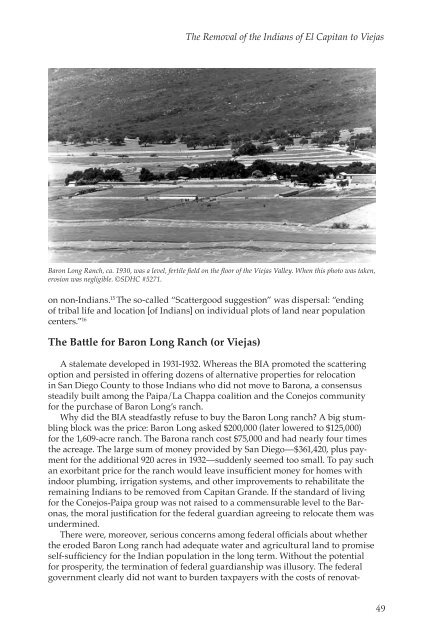You also want an ePaper? Increase the reach of your titles
YUMPU automatically turns print PDFs into web optimized ePapers that Google loves.
The Removal of the Indians of El Capitan to Viejas<br />
Baron Long Ranch, ca. 1930, was a level, fertile field on the floor of the Viejas Valley. When this photo was taken,<br />
erosion was negligible. ©SDHC #5271.<br />
on non-Indians. 15 The so-called “Scattergood suggestion” was dispersal: “ending<br />
of tribal life and location [of Indians] on individual plots of land near population<br />
centers.” 16<br />
The Battle for Baron Long Ranch (or Viejas)<br />
A stalemate developed in 1931-1932. Whereas the BIA promoted the scattering<br />
option and persisted in offering dozens of alternative properties for relocation<br />
in <strong>San</strong> <strong>Diego</strong> County to those Indians who did not move to Barona, a consensus<br />
steadily built among the Paipa/La Chappa coalition and the Conejos community<br />
for the purchase of Baron Long’s ranch.<br />
Why did the BIA steadfastly refuse to buy the Baron Long ranch? A big stumbling<br />
block was the price: Baron Long asked $200,000 (later lowered to $125,000)<br />
for the 1,609-acre ranch. The Barona ranch cost $75,000 and had nearly four times<br />
the acreage. The large sum of money provided by <strong>San</strong> <strong>Diego</strong>—$361,420, plus payment<br />
for the additional 920 acres in 1932—suddenly seemed too small. To pay such<br />
an exorbitant price for the ranch would leave insufficient money for homes with<br />
indoor plumbing, irrigation systems, and other improvements to rehabilitate the<br />
remaining Indians to be removed from Capitan Grande. If the standard of living<br />
for the Conejos-Paipa group was not raised to a commensurable level to the Baronas,<br />
the moral justification for the federal guardian agreeing to relocate them was<br />
undermined.<br />
There were, moreover, serious concerns among federal officials about whether<br />
the eroded Baron Long ranch had adequate water and agricultural land to promise<br />
self-sufficiency for the Indian population in the long term. Without the potential<br />
for prosperity, the termination of federal guardianship was illusory. The federal<br />
government clearly did not want to burden taxpayers with the costs of renovat-<br />
49







![[PDF] The Journal of San Diego History Vol 52: Nos 1 & 2](https://img.yumpu.com/25984149/1/172x260/pdf-the-journal-of-san-diego-history-vol-52-nos-1-2.jpg?quality=85)

![[PDF] The Journal of San Diego History - San Diego History Center](https://img.yumpu.com/25984131/1/172x260/pdf-the-journal-of-san-diego-history-san-diego-history-center.jpg?quality=85)






